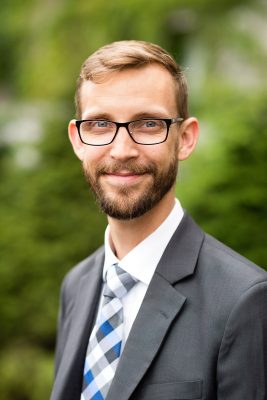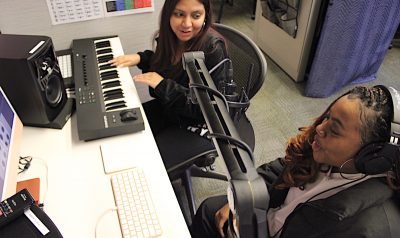You are probably familiar with traditional school music learning. Starting in elementary grades with simple instruments such as recorders and xylophones through to chorus and jazz and marching bands in high school, music teaching often involves large ensemble instruction with one teacher addressing many students playing live instruments.
 Modern music technology—and in particular digital audio workstations (DAWs), such as Garage Band or Soundtrap—are changing that paradigm. But by how much and to what end? New research by David Knapp, Assistant Professor of Music Education in the School of Education and College of Visual and Performing Arts, sets out to assess the extent to which creating, arranging, and storing digital music online has increased in music education classrooms, especially during and after the coronavirus pandemic that sent learning online in 2020-2021.
Modern music technology—and in particular digital audio workstations (DAWs), such as Garage Band or Soundtrap—are changing that paradigm. But by how much and to what end? New research by David Knapp, Assistant Professor of Music Education in the School of Education and College of Visual and Performing Arts, sets out to assess the extent to which creating, arranging, and storing digital music online has increased in music education classrooms, especially during and after the coronavirus pandemic that sent learning online in 2020-2021.
In doing so, Knapp is exploring how affordable DAWs are making music education more democratic, equitable, and inclusive; how they are shifting music education away from performance toward computer-mediated creativity and composition that may appeal to more students; and how big data collected on their use—given that students’ creative behaviors are automatically encoded—can give researchers new insights into music learning that were once unfathomable.
“As practices and practitioners in our field move farther into digital spaces, we will need to develop new research methodologies that respond to these new spaces and attend to the different ways music making and learning are taking place,” explain Knapp and his co-authors in “Soundtrap During COVID-19: A Machine-learning Approach to Assess the Effects of the Pandemic on Music Education” (Research Studies in Music Education, 2023).
Knapp sat down to explain the background of this research project, why he chose to study Soundtrap’s use, how his research is being applied to his teaching and practice, and the exciting future of digital music making in schools.
“By removing typical barriers to participation—like cost or the requirement to read standard musical notation—more students and more diverse students are able to participate.”
Q: You believe this is the first example of research into digital music making and machine learning in the field of music education—why is now the time to examine this topic?
A: Others in musicology and elsewhere have previously used large data sets, but I believe this is first use of digital music datasets in music education research. Music education is a field typified by large in-person ensembles, but during the coronavirus pandemic, it was suddenly thrust into online learning. Teachers within the field had certainly used these technologies in the past but not to the scale we observed in this study. This sudden shift in education practices presents a timely opportunity to develop novel research methods within our field to examine these emerging and growing practices.

Q: To what extent did your interest in cloud-based DAWs grow out of your own experience making music with colleagues—and receiving inquiries from in-service music teachers—during the coronavirus lockdown?
A: To a large extent. At the beginning of the pandemic, I was getting together weekly with some colleagues at other institutions to make music using Soundtrap—what we referred to as Soundtrap Happy Hour. We’d meet up, chat about teaching during the pandemic, and then jump into making music. We gave ourselves an hour each session to produce a hit track. It was a lot of fun. We even released an album! And when we were talking, we were sharing the same stories from our graduates out in the field—that they were turning to online platforms including Soundtrap to continue their classrooms in an online space. These conversations began this specific research paper and this larger research project of using big data sets within our field.
Q: Why did you focus on the Soundtrap platform? How open was Spotify to sharing its datasets?
A: We wanted to focus on Soundtrap because of its prominent place within the online music making space. We believed its size would make it the ideal platform to interrogate. Our research team also had relationships with people at Soundtrap, including a graduate of the School of Education’s music education program. After various emails and introductions, we were able to get legal approval from Soundtrap’s parent company Spotify to use some of their anonymized data.
Q: What stood out for you in the data? Were there any surprises or a-ha moments?
A: Looking at the initial graph of the time series it is strikingly clear that something very disruptive occurred sometime in March of 2020. This wasn’t surprising at all, but being able to see it so clearly was perhaps surprising. Even more, our second analytical step of conducting a changepoint analysis pinpointed March 17 as the changepoint. In short, this was the date—according to the data—that divided pre-COVID from COVID. And thinking back to our own experiences that semester, this date corresponds very closely to what we all experienced. So to be able to use big data in this way to represent something real in our lives was certainly an a-ha moment.
Q: Are DAWs here to stay in schools? If they are revolutionizing the way music is taught, are they also democratizing it and making it more equitable and inclusive?
A: These music making practices are here, have been here, and will continue to evolve into new and different platforms as far as I can see. I’m certain that these platforms—including but not limited to Soundtrap—have an impact on inclusive music practices. I see it with my own eyes when I visit some of our community partner programs and high school-aged students walk in to show off the track they made using free apps on their phone. They then bring that into Soundtrap and keep working. By removing typical barriers to participation—like cost or the requirement to read standard musical notation—more students and more diverse students are able to participate.
Q: How does this research inform your teaching practice, particular of pre-service music educators through the Syracuse University School of Education?
A: Research demonstrates that music education students typically choose their major because they had a great time in a large ensemble like band, chorus, or orchestra during high school. When they discover the other opportunities within the field and get excited about these emerging practices, they wonder “is anyone else doing these kinds of things?” Well, this initial research project demonstrates very clearly the degree to which our field adopted digital teaching and learning practices during the pandemic. Using this, I can show them that if a large portion of our field moved to Soundtrap overnight and developed new curricular strategies, there is a path for you too.
Q: Research answers often lead to more research questions—what are some of your next lines of inquiry in regard to digital music making?
A: So many that I sometimes can’t sleep at night—I’m too busy thinking about the data. This initial study uses anonymized user login data. However, because the musical behavior taking place here (making beats on a digital platform) is inherently digital, that means the musical products students are making are digital. And very large. Tens of billions of data points. Simple pedagogical questions can be easily answered using these large data sets. For example, “does the use of a MIDI keyboard increase student engagement in these platforms?” Well, we can look at that. More abstractly, would we be able to map out the kinds of tracks students are creating by examining the musical features of their compositions, such as their rhythms, melodies, and form? There are data for that question also.
Q: As a musician and music teacher, what are your thoughts on where more democratized digital music making is taking music production?
A: As a creator, I am very excited. I find these platforms to be joyful and musically compelling. As a teacher, I am just as excited. Students are able to walk into a room and instantly engage in musical practices. Once they’re in the door, the barriers have been removed. My hope is that curricula and pedagogies that center these musical practices will proliferate and make accessibility in our field less of an issue than it is now.
